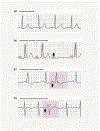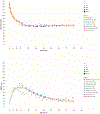Publication guidelines for human heart rate and heart rate variability studies in psychophysiology-Part 1: Physiological underpinnings and foundations of measurement
- PMID: 38873876
- PMCID: PMC11539922
- DOI: 10.1111/psyp.14604
Publication guidelines for human heart rate and heart rate variability studies in psychophysiology-Part 1: Physiological underpinnings and foundations of measurement
Abstract
This Committee Report provides methodological, interpretive, and reporting guidance for researchers who use measures of heart rate (HR) and heart rate variability (HRV) in psychophysiological research. We provide brief summaries of best practices in measuring HR and HRV via electrocardiographic and photoplethysmographic signals in laboratory, field (ambulatory), and brain-imaging contexts to address research questions incorporating measures of HR and HRV. The Report emphasizes evidence for the strengths and weaknesses of different recording and derivation methods for measures of HR and HRV. Along with this guidance, the Report reviews what is known about the origin of the heartbeat and its neural control, including factors that produce and influence HRV metrics. The Report concludes with checklists to guide authors in study design and analysis considerations, as well as guidance on the reporting of key methodological details and characteristics of the samples under study. It is expected that rigorous and transparent recording and reporting of HR and HRV measures will strengthen inferences across the many applications of these metrics in psychophysiology. The prior Committee Reports on HR and HRV are several decades old. Since their appearance, technologies for human cardiac and vascular monitoring in laboratory and daily life (i.e., ambulatory) contexts have greatly expanded. This Committee Report was prepared for the Society for Psychophysiological Research to provide updated methodological and interpretive guidance, as well as to summarize best practices for reporting HR and HRV studies in humans.
Keywords: guidelines; heart rate; heart rate variability; methodology; respiratory sinus arrhythmia; statistics; study design.
© 2024 The Authors. Psychophysiology published by Wiley Periodicals LLC on behalf of Society for Psychophysiological Research.
Conflict of interest statement
CONFLICT OF INTEREST STATEMENT
The authors declare no conflicts of interest with respect to their authorship or the publication of this article.
Figures












References
-
- Ahmed MW, Kadish AH, Parker MA, & Goldberger JJ (1994). Effect of physiologic and pharmacologic adrenergic stimulation on heart rate variability. Journal of the American College of Cardiology, 24(4), 1082–1090. - PubMed
-
- Akselrod S, Gordon D, Madwed JB, Snidman NC, Shannon DC, & Cohen RJ (1985). Hemodynamic regulation: Investigation by spectral analysis. American Journal of Physiology. Heart and Circulatory Physiology, 249(4), H867–H875. - PubMed
-
- Akselrod S, Gordon D, Ubel FA, Shannon DC, Berger AC, & Cohen RJ (1981). Power spectrum analysis of heart rate fluctuation: A quantitative probe of beat-to-beat cardiovascular control. Science, 213(4504), 220–222. http://www.ncbi.nlm.nih.gov/pubmed/6166045 - PubMed
-
- Alcantara JMA, Plaza-Florido A, Amaro-Gahete FJ, Acosta FM, Migueles JH, Molina-Garcia P, Sacha J, Sanchez-Delgado G, & Martinez-Tellez B (2020). Impact of using different levels of threshold-based artefact correction on the quantification of heart rate variability in three independent human cohorts. Journal of Clinical Medicine, 9(2), 325. 10.3390/jcm9020325 - DOI - PMC - PubMed
Publication types
MeSH terms
Grants and funding
- 1R01CA258269-01/NIH-National Cancer Institute
- NHLBI P01-040962/NIH-National Heart Lung and Blood Institute
- NIMH-R01MH109464/NIH-National Institutes of Mental Health
- R01 MH113234/MH/NIMH NIH HHS/United States
- NIMH-R01MH113234/NIH-National Institute for Mental Health
- U01 CA193632/CA/NCI NIH HHS/United States
- 1U01CA193632-01A1/NIH-National Cancer Institute
- W911NF-16-1-0191/Army Research Institute for the Behavioral and Social Sciences
- R01 CA258269/CA/NCI NIH HHS/United States
- OSU Emeritus Academy Grant
- R01 MH109464/MH/NIMH NIH HHS/United States
- P01 HL040962/HL/NHLBI NIH HHS/United States
LinkOut - more resources
Full Text Sources

